In this article, we are going to introduce you a woodworking trick named: wood joints without nails.
In the carpentry industry, you usually need to put different pieces of wood alongside and join them together to make a project.
To do this, traditionally nails and glues are being used. But it’s interesting to know that the carpenters had invented methods of wood joints before the emergence of nails and glues.
For example, Japanese carpenters used a series of puzzle joints to attach wooden parts to a structure.
They used these tricks, even in building the houses.
It can be said that today, these methods have been fashioned again, and carpenters have devised innovative methods for wood joints without nails or even glue.
you can use nails, screws, tacks, or brackets to form the joints. It makes work easy to do, but some carpenters use without nails techniques to show their talent.
Lichtenberg Wood Burning eBook

Download Lichtenberg Wood Burning eBook
One of the modern techniques for creating wooden artwork is called Lichtenberg wood Burning. In this eBook, we are going to introduce this newfound art to you.
This technique is known with some different names such as Lichtenberg wood burning, fractal wood burning, and electricity wood art.
This technique should not be confused with wood burning art or pyrography. The art of pyrography on wood is the art of creating motifs and designs by burning with hot metal tools on objects such as wooden surfaces.
Lichtenberg burning is a wood-burning technique for creating designs with electricity.
This eBook is a comprehensive guide on Lichtenberg Wood Burning. All you need to know for Lichtenberg Wood Burning is here.
This is a limited-time offer, order now to get access to the future eBook releases.
On the other hand, this kind of fittings is more beautiful and attractive because they are completely invisible.
We introduce here a list of wood joining methods which you can build your own wooden projects with them without using nails.
Advantages of Joints Without Nails
The first advantage of wood joints without nails or other metal screws is that if you do not have these objects, you can build a wooden project! but there are other advantages too for these joints:
- By using these techniques, you can save on the cost of metal fasteners.
- One of the important advantages of wood joints without nails is that if necessary, you can unplug them and rejoin them again.
- Wood joints without nails allow the wood to move with seasonal shrinkage and expansion. The movement of the wood in any project, as well as moisture air, can loosen any glued wood joint. But wood joints without nails are flexible against these problems.
Categories of Wood Joints
Before examining the wood joints without nails, let’s talk a little about the types of wood joints.
There are many categories of wood joints and Wood Joining Techniques in the woodworking industry.
All joints are divided into categories in terms of their uses. After defining some of these connections and their terminology, we will discuss the main subject.
Butt joints
In fact, the joints in which two pieces of wood are placed butt together called butt joint. See the picture below.
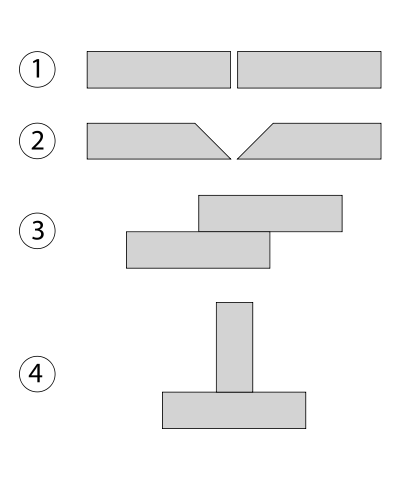
For this purpose, types of nails and glue or applied techniques of wood joints without nails may be used.
Butt joints are a connection for sticks in which two part of a wooden project is joined by simply placing their ends together without any special shaping.
Wood Corner Joints
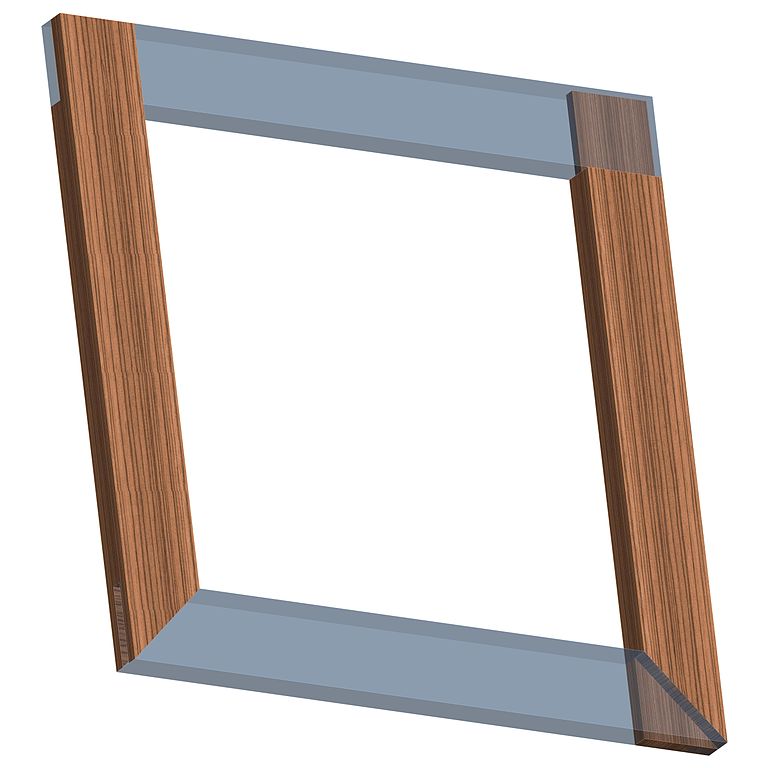
As the name implies, Wood corner joints are used to connect the corners of the wooden projects.
For example, when you are building a window frame, you’ll need to use corner joints techniques.
It can be said that the corner joints are the most important carpentry joints that have many uses in the design of wooden projects.
There are many simple or complex
- Half lap joint
- Bevel lap joint
- Dovetail joint
- Bridle joint
Lengthening Joints
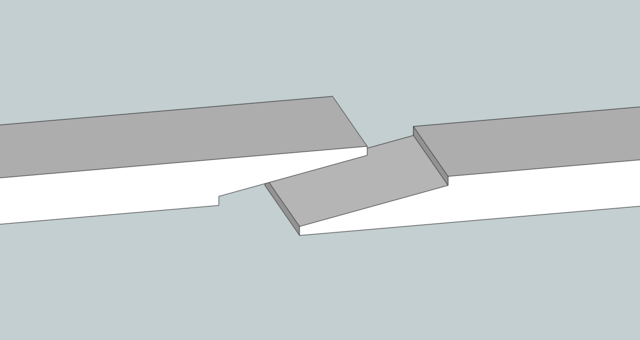
Lengthening joints
Timber often has to be lengthened in big projects such as the floor.
Lengthening joints are mainly used to connect two timber lengthwise.
Usually for fixing of parts used screw and wood glue in this joint.
The most famous Lengthening joints can be pointed like:
- Scarf joint
- Lapped joint
- Splayed lap
Cross Joints and Halving Joints

This joint is one of the wood joint models used in some projects. For example, for windows where the glass is separated.
Cross and halving joints are used when two intersecting beams have to be fixed.
The most famous Cross joints and halving joints are:
- Halved crossing joint
- Double notched joint
- Crossed tenon joint
- Dovetail lap joint
- T-Bridle Joint
Framing joints
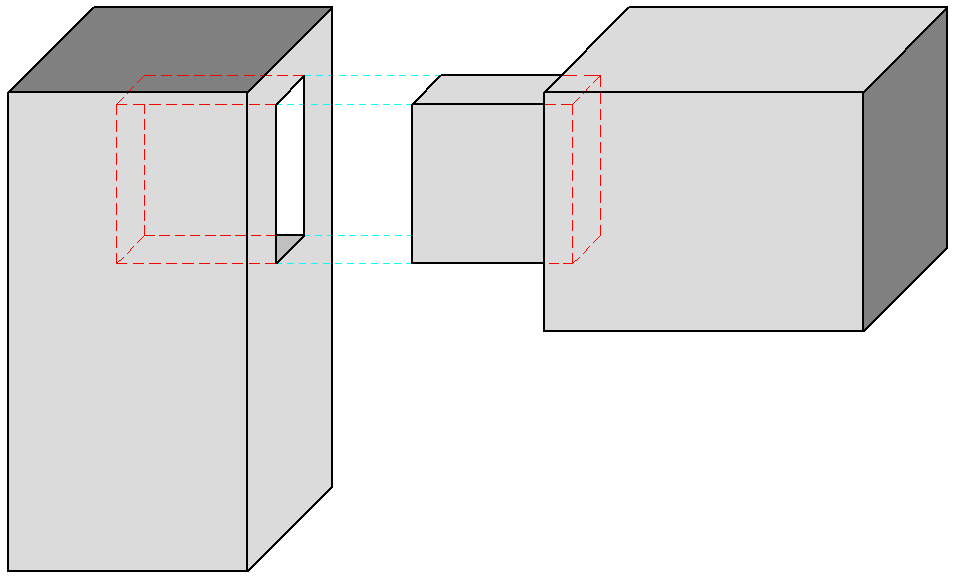
There are categoreis of joints that use the tenons to connect the two sections of wood.
This category is called Framing joints. These joints can be used to connect two part of timber in different angles.
The most famous Framing joint is
Wood Joints Without Nails
Dovetail Joint
This joint may be the most interesting and classical wood joint.
Professional carpenters and woodworking art enthusiasts use Dovetail joint to enhance the quality of their work and along with that, show their expertise and capabilities.
If you browse through the social networking pages of woodworking masters, you can see their thirst to use this type of joining.
It is also known as Finger joint. This connection is suitable for Wood corner joints and that is an important part of the projects.
If two parts of Dovetail joint have different colors, it’ll be more beautiful.
The correct way to cut and assemble these joints is very important. This joint consists of pins on a board that goes inside into the triangular space between the tails on the other board.
When properly cut and assembled, they create a solid linkage. This requires accuracy cutting and can be difficult for a beginner to make a well wood joint.
With the connection of this joint, you can create different types of the drawer, bed, table, and wooden shelves without using a nail.
There are different types of dovetail joints that we will review them.
Through Dovetail joint
Through Dovetail joint is the most classical dovetail joint.
In this joint when the joint is assembled, at the junction pins and tails, both boards of wood are visible.
See the below picture.
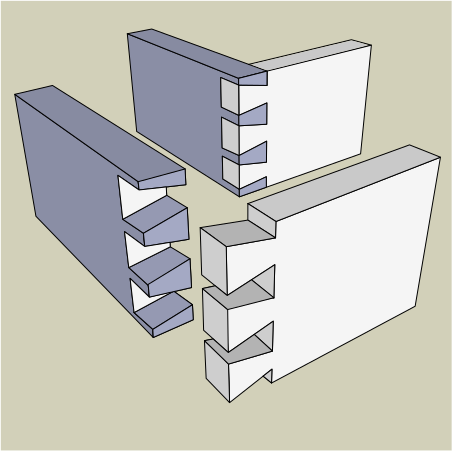
Box Joint
Actually Box Joint is an alternative to the through-dovetail joint that can be created very simply and easily.
This joint is very like a dovetail joint, with a little difference, the sides of the pins and tails are cut perfectly square.
Woodworkers usually use a bit of glue to secure the joint.
You can see the difference between these two joints in figures.

Half-Blind Dovetail
The difference between the Half-Blind Dovetail and Through Dovetail is that in Half-Blind Dovetail only one face of the joint shows the dovetails.
Hence, the name of this joint is half blind. See the picture below.
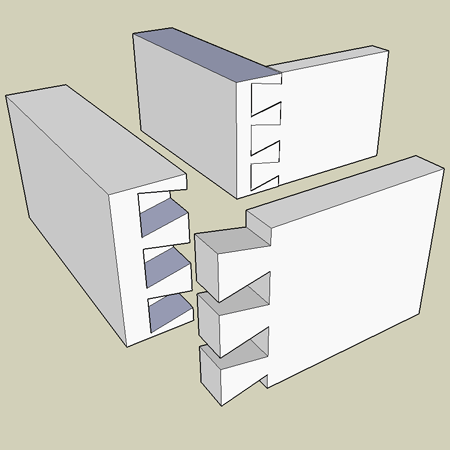
Secret Mitred Dovetail
The secret mitred dovetail joint that also called ‘full-blind mitred dovetail’, is one of the
This joint usually is being used in the highest class of woodworking projects like kitchen cabinets.
It offers a strong connection which is totally hidden from both outside faces of the wood joint.
In fact, you are not able to see pins and tiles from the outside.
Sliding Dovetail
The sliding dovetail is a method of joining two boards at right angles, where the intersection occurs within the middle of one of the boards and at the end of the other one.
Actually Sliding dovetail joint is not a corner joint.
In that, it uses just one long pin that slides into a matching tail slot to make a join for the two boards of wood.
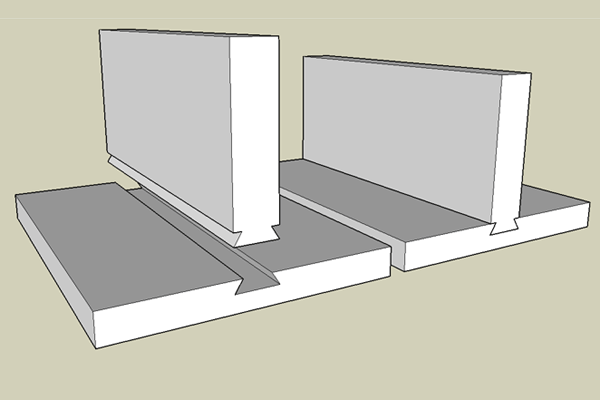
Bridle Joint
A bridle joint is a woodworking joint that is similar to the box joint. With the difference that there is only one pin and one tile here.
Bridle joint is one of the simplest joints, however, it requires accuracy for making.
These joints are very suitable for making door and window frames.
This connection is categorized in
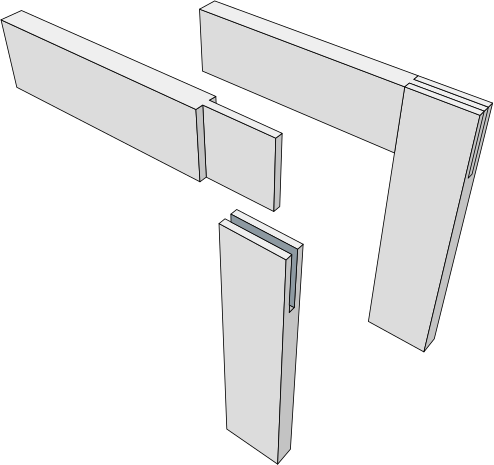
T-Bridle Joint
T-Bridle Joint is a kind of bridle joint.
This connection is very strong and useful for joining two pieces of timber together.
This joint is a functional connection which joins the end of one part to the middle of another part.
The reason for naming this joint is indicated clearly in the image below.
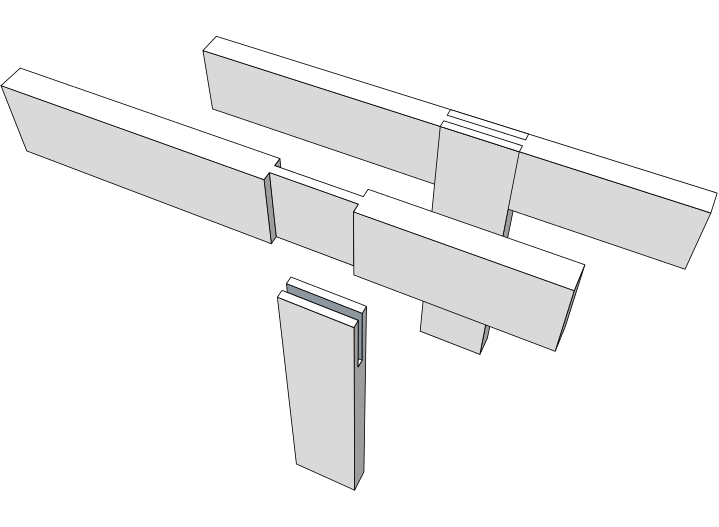
Dowel Joints
Dowel Joints can be used to connect two sticks of wood in Butt Joints in any jointing configuration.
In this joint two or more round pieces of wood, are inserted into corresponding holes in two adjoining parts to hold them together.
These wooden pins are known as dowels.
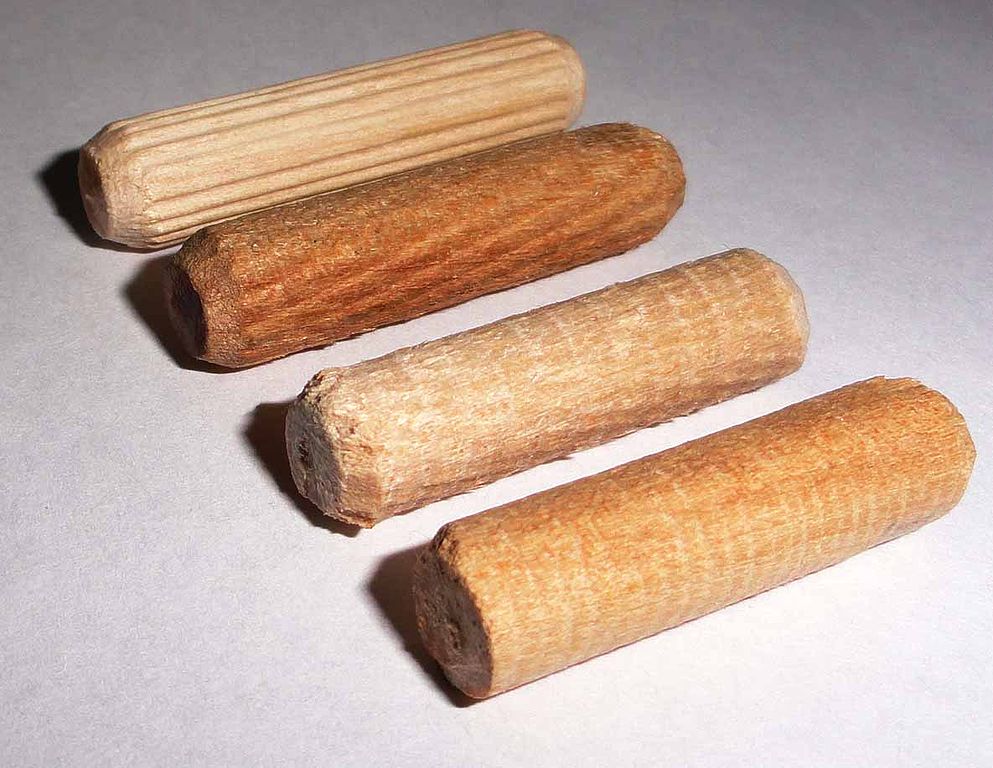
To strengthen the joints, the dowels should be immersed in the glue and then driven into holes made for their reception.
Without the addition of glue, you can easily break apart this joint only using your hands.
Although Dowel Joints are very simple in construction, they are not easy to make.
If you are a beginner, before using it on any project, you should try it on two pieces of scrap wood.
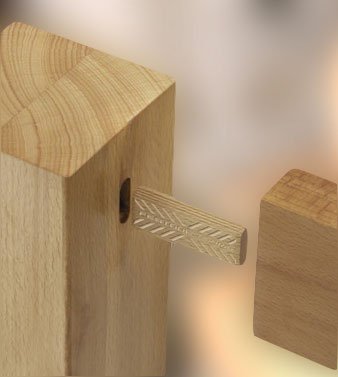
Mortise and Tenon Joint
Mortise and Tenon Joint is one of the wood joint methods without nails that is categorized as Framing Joints.
It’s a great way to join two wood pieces that used to build doors and windows, ladders, tables, chairs, and so on.
According to wood mechanic experiments, woodworkers have learned that it is one of the most powerful wood joints.
If you use glue, then fitting pieces will not move and are very difficult to be separated.
The premise of a mortise-and-tenon joint is very simple. It contains a square or rectangular hole in one board, known as a mortise, and a wooden pin on another board to match, which is called a tenon.
Usually, these joints can be cut by hand, using chisels. Look at the below picture.
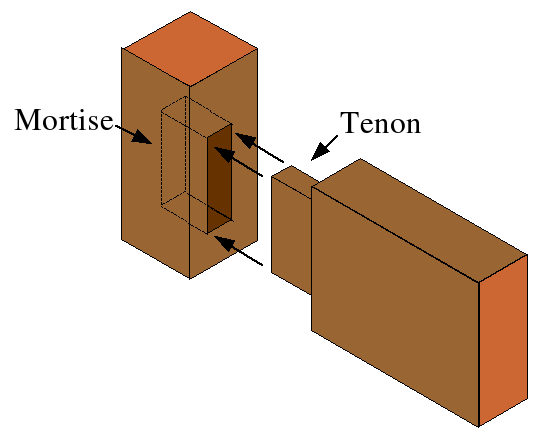
This way is a usual kind of Mortise and Tenon Joint. This joint can be done in several ways, but the basics of all are the same.
Conclusion
We introduced a list of Wood joints without nails in this article.
Certainly, this doesn’t include all types of these joints. But these are the most famous and most practical joints without nails or other metal screws.
From these joints, types of Dovetail joint and Bridle Joint, have the best result in corner joints.
Usually, joints without nails are more applicable at a 90 ° angle and it will be more robust at this angle.
Each of them can be useful for you with different uses.
As you can see, Wood joints without nails are not widely used for Lengthening joints. Lengthening joints without nail or screws, will not be strong enough.
Though joints without nails have good advantages, you should use them for a suitable situation and not for all.
We suggest that if you do not intend to unplug your project, be sure to use a little glue as a help for more strength.



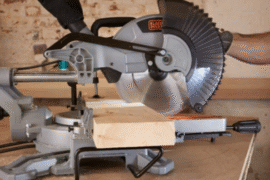


Comments
Pingback: What is Wood Made of? | Wood Dad
Pingback: 8 Simple Wood Joints For Beginners | Wood Dad
Pingback: 9 Cool and Innovative Woodworking Tricks | Wood Dad
Pingback: +50 Old Woodworking Photos – Wood Dad | WoodWorkers
Pingback: What is Kumiko Woodworking? - Wood Dad